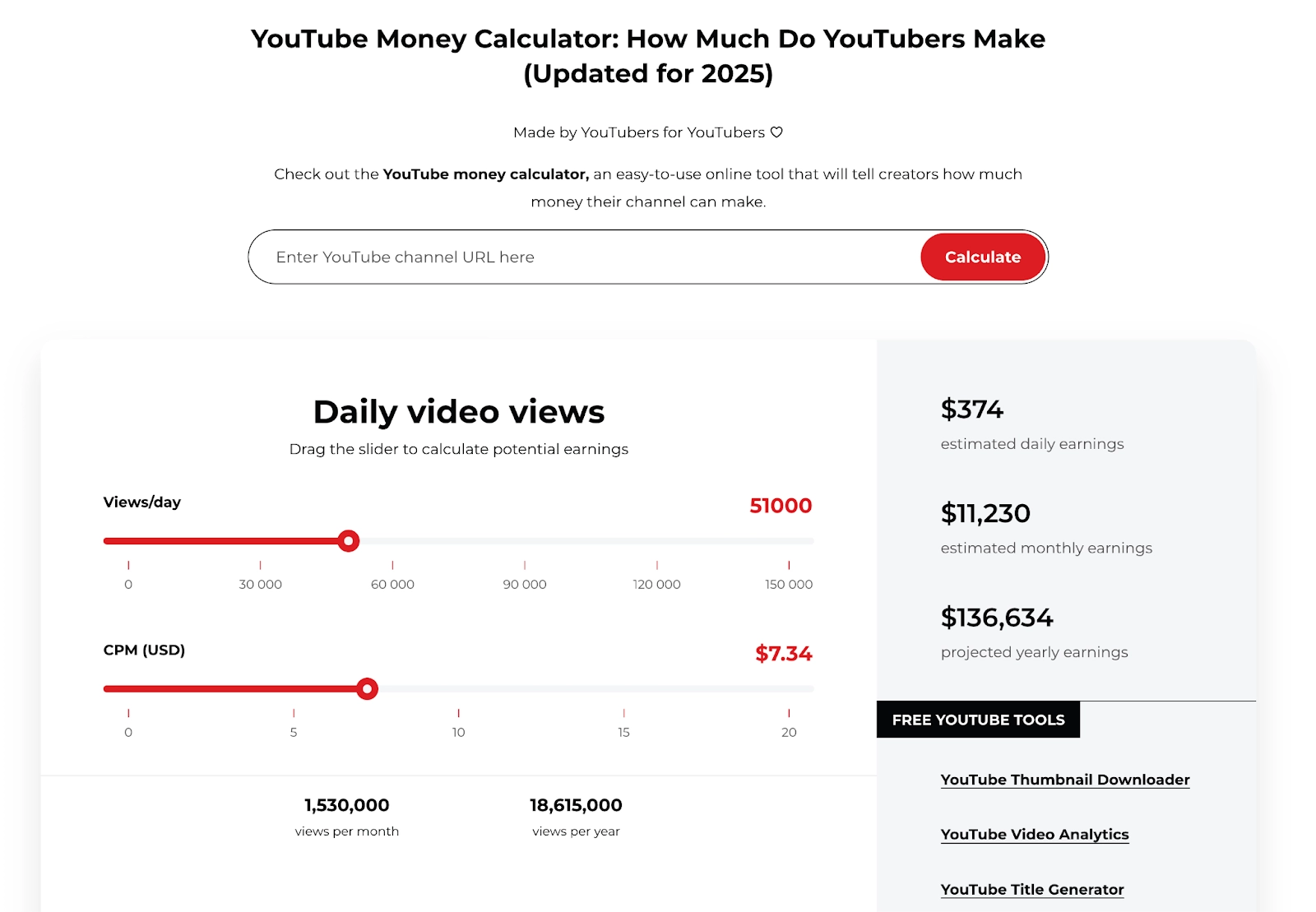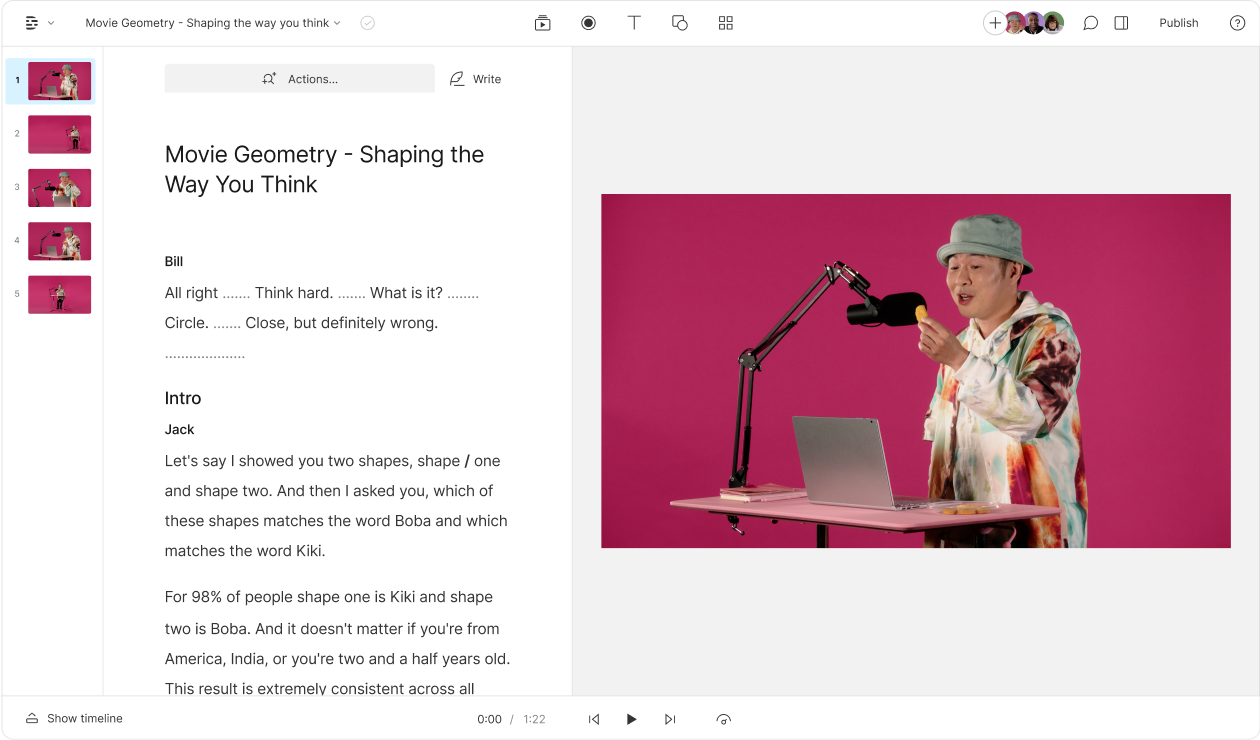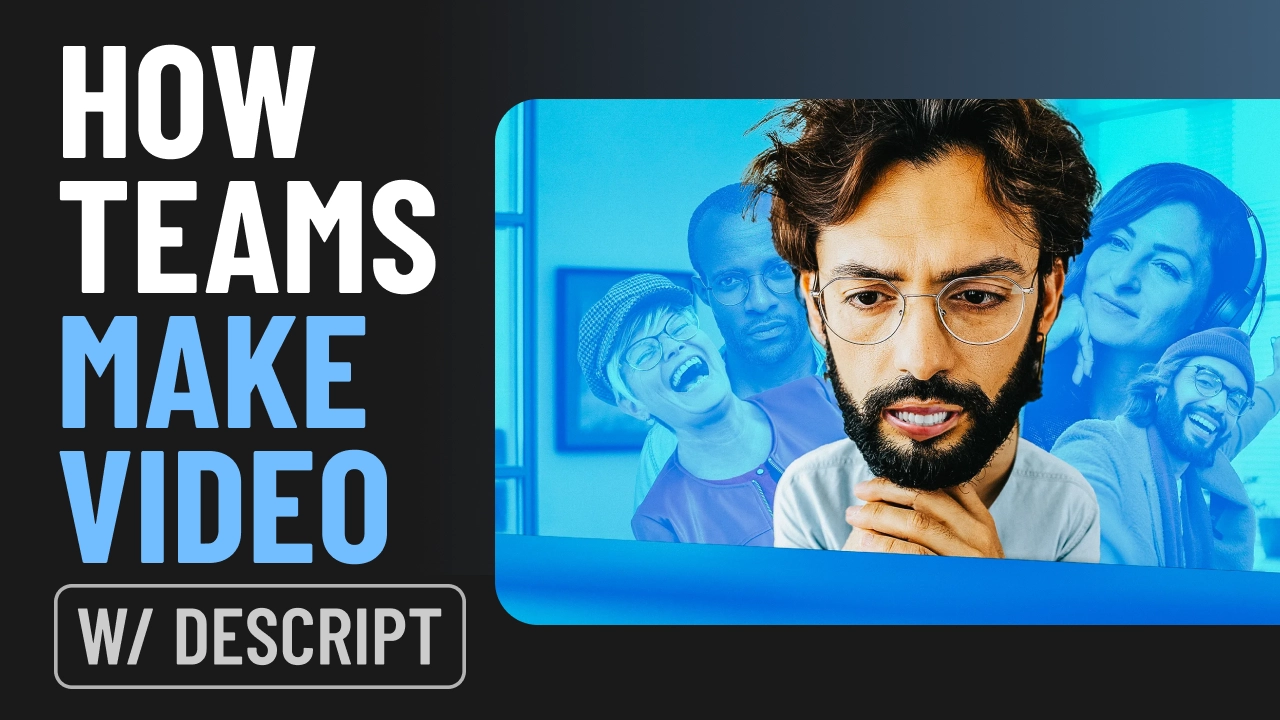What type of content do you primarily create?




The internet is flooded with wild claims about YouTube riches—from 'anyone can become a millionaire' to 'it's impossible to earn a living.' If you're considering starting a YouTube channel or growing your existing one, you deserve some actual numbers, not more hype.
The short answer is: Most YouTubers earn between $5 and $15 per thousand views—though some make less while others rake in significantly more. Yes, that's a wide range, and for good reason.
Your 100,000-view video might generate $500-$2,000. Then YouTube swoops in for its cut, leaving you with about $250-$1,000. Not exactly quit-your-job money for most creators, despite what the success stories suggest.
So, what can you realistically earn without those aspirational six-figure view counts? We're about to break down the numbers without the usual sugar-coating.
How YouTubers make money
One of the primary ways to monetize content is through advertising. YouTube creators can generally make money from two kinds of ad services.
YouTube AdSense: How creators get paid
First, there's AdSense, Google’s program that lets creators earn money by showing ads on their content. They can be ads that play before or during your videos, or ads that appear between videos in the Shorts feed.
There are two metrics to understand about this type of revenue:
- CPM (Cost Per Mille): This stands for ‘Cost Per 1,000 Impressions.’ It's the amount an advertiser pays YouTube for every 1,000 times their ad is shown.
- RPM (Revenue Per Mille): This stands for ‘Revenue Per 1,000 Views.’ It’s your actual share of revenue per 1,000 video views, after YouTube takes its cut.
For creators, RPM is the more important metric as it reflects your actual earnings. YouTube's share is 45% for traditional long-form videos, leaving you with 55%. For YouTube Shorts, ad revenue is pooled, and creators collectively receive 45% of it.
Pretty clear cut, no? But there are actually lots of factors that affect your Google AdSense revenue. Here is what dictates your ad rates:
- Your niche. This is the Big One — advertisers pay top dollars to reach high-value audiences. A channel reviewing luxury cards or sharing personal finance advice will have a higher CPM because car brands and banks are willing to bid more to reach those viewers. Niche channels like cooking, gaming, or reaction channels tend to have lower CPMs because their audiences are more general.
- Your audience location. Where your viewers are from matters a lot. Advertisers pay far more to reach audiences in high-income countries like the United States, the United Kingdom, and Canada. A view from the US can be worth 2 or 3 times as much as one from a developing country, just because that audience has more spending power.
- Video length. If your video is longer than 8 minutes, YouTube lets you place mid-roll ads. More ad slots mean more opportunities to earn revenue, if your viewers stick around long enough to see them (so produce interesting YouTube videos!).
- Seasonality. Ad budgets change with the seasons. Advertisers spend more during peak consumer spending periods, such as the last quarter of the year (October to December). Higher CPMs can result in a bigger AdSense check during those months, followed by a notorious drop in January.
Sponsorships: How brands pay YouTubers
We’ve established that AdSense is generally a long, slow grind. You’ve seen the numbers—even a viral 100,000-view video might only net you a grand.
The million-subscriber channels aren’t living large off YouTube ad revenue alone. They are creating partnerships with brands to promote their products. You’ve seen these a thousand times. The 60-second "shout-out" where the host talks directly about a VPN, a mobile game, or a Squarespace website.
With sponsorships, there is no revenue share. You negotiate the rate and keep 100% of the fee. Sponsorships are where the real advertising money is flowing. According to Statista, brands are forecast to spend $9.29 billion on sponsored content in the US alone in 2025. That’s the massive pie you’re fighting for a slice of.
Just like with AdSense, your niche dictates your price tag. Brands will pay a premium to reach a focused audience. If a company wants to sell expensive podcasting mics, they'll get a much better return by paying top dollar to a podcasting tips channel (even a small one) than by advertising on a giant, general-interest news channel.
Updated YouTube earnings data for 2025 & what it means for 2026
So, how is the business of YouTube doing? Because when the platform makes money, you eventually make money. At the moment, YouTube is on a tear.
In late 2024, its combined ad and subscription revenue blasted through $50 billion over the previous 12-month period. It then set a record with $10.47 billion in the fourth quarter, followed by a massive $9.79 billion in 2025.
That’s fantastic for Google’s stock, and also for you. Analysts cite that YouTube could be a $70 billion business by 2026. All this new cash is coming from two things:
- Aggressive Shorts monetization: YouTube’s CEO Neal Mohan recently said Shorts are hitting over 200 billion daily views. They’re now pushing Shorts onto Smart TV apps, letting brands create Shorts-exclusive ad campaigns, and even changed the definition of a Short view to match TikTok, so top-line view counts look bigger and attract more ad dollars.
- The shopping gold rush: YouTube is eager to turn your channel into a storefront. All those new features, like affiliate tagging, direct Shopify integrations, and product collections, are encouraging you to sell products from your videos.
More overall advertiser demand plus new money from Shopping and Shorts can create upward pressure on ad rates. If that’s the case, you could see a lift in your RPMs, especially if you're in a high-spend niche that advertisers are fighting over like finance, tech, and all those new AI tool channels.
It’s not a guarantee that your advertising revenue will double, but it’s a good sign for the creator ecosystem overall.
🔎 Quick reality check: When you see reports that MrBeast is making $85 million a year (an estimate from Forbes, not an audit), remember that is not a typical outcome. That's a global media empire, not just a YouTuber. Treat those figures as what is possible, not what is probable.
How many views do YouTubers need to earn money?
To make money from AdSense on YouTube, you need to get into the YouTube Partner Program (YPP), in which creators earn a portion of the money advertisers pay YouTube to display ads on videos. The criteria are as follows:
You need at least 1,000 YouTube subscribers, plus either:
- 4,000 hours of watch time on your content in the last year or
- 10 million views on your Shorts in the last 90 days
Creators also need to abide by all of YouTube's monetization policies.
How much do new YouTubers make when starting out?
If you've just cracked 1,000 subscribers, what can you expect to make? It depends entirely on your niche and video views—having a breakout video could increase revenue for weeks. Generally, YouTubers with 1,000 subscribers might earn between $20-$200 per month if they're consistently posting and getting decent viewership.
But it helps to hear from smaller creators to understand the range you might expect. In a Reddit thread, one creator in the travel niche with 1,370 subscribers commented that they were making $100 a month off of 23,000 views. Another with 1,250 subscribers reported making $83 in their first week. Yet another creator with 6,000 subscribers only makes $60 per month. It's a wide range!
Guidance on transitioning from part-time to full-time YouTube income
Many content creators find that hitting around 10,000 daily views is a practical threshold for leaving their day job behind. Aiming for at least 50,000 subscribers can also help solidify recurring ad revenue and brand deals.
Multiple income streams, such as affiliate marketing or merchandise, can increase financial stability and mitigate seasonal ad fluctuations. Creators should also track key metrics like watch time and subscriber growth to evaluate when the leap to full-time is truly feasible.
While consistent, high-quality uploads are critical, so is understanding audience feedback and pivoting content strategies. By focusing on engagement and careful business planning, many smaller YouTube channels can rapidly scale to support full-time work within a year.
YouTube Studio: The analytics engine behind smart growth
YouTube Studio is amazing for optimizing and growing your channel. But it’s so easy to get lost in the sea of vanity metrics, as with any analytics platform. If you want to make money, focus on a few key reports:k
- The Revenue tab. Here is where you’ll find your paycheck. It’ll show your playback-based CPM and RPM. You’ll also see your top-earning videos, which is like YouTube literally telling you, “this topic makes you more money than other topics.”
- Real time performance. A great dopamine hit, your real time report shows what’s happening right now with views in the last 60 minutes and last 48 hours. It’s great for one thing—seeing if a new video’s title and thumbnail are working. If you see a huge spike, you nailed it. If it’s a flatline, the video is dead on arrival.
- Reach. The Reach report shows your traffic sources. It’ll show you the keywords people are typing to find you, if your videos are being recommended next to other popular content, and other websites and apps sending you views.
- Audience retention. The Key moments for audience retention graph shows you exactly where viewers are skipping, re-watching, or just leaving entirely. Big dips mean you were boring — maybe your intro was too long, ad read too clunky, or your points were confusing. Spikes suggest you did something great that made people re-watch… do more of that.
YouTuber earnings from 1,000 to 1 million subs
As your channel grows, sponsorship opportunities can help supplement your AdSense revenue. Your audience size and dedication may even enable a sustainable amount of revenue from channel memberships or merchandise.
Like AdSense, sponsorship rates can vary widely by niche. They are also usually calculated using CPM. And broadly speaking, those tend to be between $30 and $70, though many creators have probably taken deals in the $10–$20 range.
Some brands, especially e-commerce brands or mobile games, might prefer to pay out based on sign-ups or sales made. In my own experience, these are usually lower-quality deals reserved for creators without much bargaining power. Successful YouTubers with dedicated audiences can often negotiate much better terms.
Though you can't exactly determine how well your sponsored video will do, advertisers often will set a fixed price based on the estimated number of views or choose to pay for actual views (though they often set a cap, in case a video goes viral and beyond their budget).
The wide range of CPMs might seem confusing, but it speaks to the importance of having a strong business plan if you want to take your channel from a hobby to a career.
Many creators also supplement their income by launching brands or selling products. That might mean selling merch like T-shirts, but there are also more ambitious examples like MrBeast's line of Feastable chocolates. Creators can use YouTube's shopping features to promote their products.
Another strategy is membership programs, either through YouTube's own membership feature or something like Patreon. These memberships allow fans to pay monthly to earn access to exclusive content or perks from the creator.
YouTube's affiliate program provides yet another revenue stream. It allows creators to tag products in their videos and receive a commission if they're purchased. This feature is only available for creators with more than 15,000 subscribers.
How much mid-sized YouTubers actually make
For a look at what these mid-sized creators can actually make, let's look at two examples.

Celine, a creator with 31,000 subscribers, made $5,500 from a little under a million views.
Creator Katie Steckly, with 272,000 subscribers, reports making over $217,000 in brand deals in 2023, a sizeable portion of her $500,000 income that includes courses and digital products. Only $43,000 came from AdSense.
Celine, left, made $5,500 in a year with just under 1 million views. Katie Steckly, right, made $43,000 from video ads in a year with 272,000 subscribers.
How much do YouTubers make with 1 million subscribers?
While new creators might think hitting 1 million subscribers is a pie-in-the-sky goal, the reality is that it's not that rare: there are 25,000–30,000 channels with 1 million subscribers.
If one of these channels published one video that got 1 million views, here's what they might make: between $2,000 and $10,000 from AdSense revenue alone, depending on their niche, audience location, and time of year. When you add sponsorships and other revenue streams, a YouTuber with 1 million subscribers could potentially earn $10,000-$30,000 per video.
- In AdSense revenue: Between $5,000 and $20,000, though YouTube will take 45% of that for its long-form revenue share.
- From brand deals: With a good brand deal, they could make between $30,0000 and $70,000.
- The brand deal might preclude you from pushing your own products or memberships, but in theory that could yield even more money.
It's entirely possible a channel with 1 million subscribers can make less money than a smaller channel with half those subscribers. Even if views are consistent, a channel reviewing music releases might not have the same opportunities as a channel that gives in-depth editing tutorial videos, and can sell both editing classes and sponsorships for editing software. This highlights why subscriber count alone doesn't determine how much YouTubers make.
Thomas Frank, a productivity YouTuber who started covering the note-taking app Notion, has the best of both worlds. He has nearly 3 million subscribers and makes over $100,000 many months selling his own Notion templates.
How much do the highest-earning YouTubers make?
According to Forbes, in 2024 the highest-paid YouTubers were:
- MrBeast: $85 million
- Matt Rife: $50 million
- Dhar Mann: $45 million
- Charli D’Amelio: $23.5 million
Note: Forbes estimates cover multi-platform creator earnings, not just Google AdSense.
YouTube Money Calculator
We’ve been through all the metrics, now let’s get to how much money you can actually make on YouTube. The YouTube Money Calculator from Views4You is an excellent option.
Here is how to use it:
- Find your daily views: Plug in your average daily views or a goal you want to hit.
- Enter your CPM (or RPM): If you're not monetized yet, start with a conservative estimate for your niche, like $5.
- See your projections: The calculator will show your potential daily, monthly, and yearly earnings.

Passive income on YouTube: What’s actually possible in 2026
The idea that you can make money while you sleep is the ultimate creator fantasy. On YouTube, this is both true and completely misleading. Yes, your video from 2024 can absolutely still earn AdSense, affiliate commissions, and YouTube premium revenue in 2026.
But passive doesn’t mean absent. The channels that build long-term stability are constantly brainstorming new ideas, planning for the future, and investing in production quality.
YouTube Shopping and affiliate tools
YouTube’s Shopping affiliate program lets you tag specific products in your long-form videos, Shorts, and live streams. When a viewer clicks and buys, you get a commission.
To be invited to the program, you have to meet the eligibility criteria:
- Your channel is in the YouTube Partner Program.
- Your channel must have more than 10,000 subscribers.
- You are based in the United States, Korea, Indonesia, Thailand, Vietnam, Malaysia, the Philippines, India, and Singapore.
- Your channel is not a music channel or set up as Made for Kids.
Once you’re in, you can earn passive-ish income. Say you tag a camera in your "Best Vlogging Gear" video once. That video gets views for the next three years, and you can earn commissions that entire time. YouTube handles all the tracking, linking, and merchant payouts on the backend.
Evergreen monetization from past videos
A daily news or trending topics video may be dead in a few days. You can monetize them for sure, but once the hype dies, so does your revenue.
Evergreen videos, like a how-to guide or a software tutorial, can earn you money for years. Find the sleepers in your catalog and optimize them:
- Fix the leaks. Go to the Key moments for audience retention graph for a top-performing old video. See a massive drop in the first 30 seconds? Maybe the intro was too long. Use the Descript video editor to trim it out.
- Refresh the thumbnail. Swap in an old thumbnail for a new, high-res version. Update your title and description, and rewrite it based on keywords you see in your Reach tab.
- Push videos globally. Got a top video performing in the US? Use Descript’s auto-dubbing feature to add a Spanish or Korean audio track. That video can find a whole new international audience and stream of revenue.
Video editing: The overlooked YouTube income booster
Thumbnails and titles get the click. Your video editing gets the watch time that gets you paid.
Creators obsess over cameras and mics, but sloppy editing is the fastest way to kill your revenue. A long, rambling intro, a 10-second "ummm" while you find your words, a static shot that never changes—these are the dips in your retention graph where viewers get bored and click away. Better videos that get more watch time tell the algorithm to promote your video further.
Back in the day, cutting your video was a 10-hour grind. Today, with new AI editing agents like Descript’s Underlord, you have a tireless collaborator that does the grunt work for you.
Got a 3-hour-long gaming stream you want to cut for YouTube? Just tell Underlord to “Find the 10 best highlights where I got a kill and turn them into a 'best of' video.”. Is your talking head video full of jump cuts. Just say, “Hide all my jump cuts with zooms and remove all my filler words.”
And just like that, the work is done for you. An AI video editor also lets you iterate on your videos. You can try five different hooks, edit for maximum engagement, and fix the boredom dips before you publish.
And, of course, this creates a brand new high-income skill. Get really good at directing an AI agent like Underlord, and you can freelance those skills to other, richer channels.
FAQ
How much does a YouTuber with 1 million subscribers make?
While it can vary wildly based on views and ad rates, one YouTuber with roughly a million subscribers reported making between $14,600 and $54,600 a month. In general, a YouTuber this size might expect to make between $2.50 and $10 for every thousand views they get, after YouTube takes its revenue share. Larger channels can also make hundreds of thousands of dollars between direct sales, brand deals, and channel memberships.
How much does a YouTuber with 100k subscribers make?
If a 100,000-subscriber channel regularly gets 100,000 views, it could earn between $500 and $1,500 per video from AdSense. Those videos might also receive between $3,000 and $7,000 for a brand deal (though it could be lower), or even more if the channel sells its own products directly. This means a mid-sized YouTuber could potentially earn $40,000-$100,000 annually with consistent posting.
How much money do YouTubers make per 1 million views?
YouTube pays between $5,000 and $7,000 for 1 million views, Hootsuite reports. But it can vary wildly based on what countries your viewers are in, your content niche, and the time of year. Finance, business, and technology channels typically earn on the higher end, while gaming and entertainment often earn less per view.
What is the average income of a YouTuber?
YouTubers in the YouTube Partner Program can make between $5 and $15 for every thousand views, but after YouTube takes its portion of the revenue, it might be closer to $2.50–$7.50. Many channels supplement this with brand deals and affiliate deals.
How might CPM rates change globally in 2026?
The ad market continues to be about geography, even in 2026. A 2025 analysis shows top-tier countries like Australia ($36.21) and the US ($32.75) commanding extremely high ad rates, while a massive market like India can still sit under $1.00.
Do sponsorships or ad revenue offer higher earning potential?
Sponsorships often provide larger upfront payouts, especially for creators with engaged audiences. In fact, a single sponsorship deal can sometimes out-earn multiple videos' worth of ad revenue. However, sponsorship income can fluctuate due to company budgets and seasonal campaigns. Meanwhile, ad revenue offers steadier, long-term income once you meet viewer and watch-hour thresholds. Balancing both streams typically yields the highest overall earnings.





























%201.svg)




















